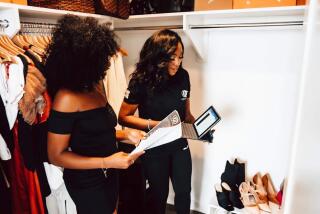Growing Numbers of African Women Qualifying for Aid Program Loans
- Share via
MBAO, Senegal — Aminata Fall, her grandmotherly face speckled with flakes of fish scale, balances a heavy basket of sardines on her head. Then she crunches her way across sand and dumps the load on the ground.
“I’m tired, tired,” she says with a smile as she heads back across the beach for another basket of the fresh fish she has just purchased to dry and sell.
Soon, she hopes to make more money and, perhaps, ease her workload--through credit. With a loan, Fall could buy larger quantities of fish for drying and selling. And she may buy a horse cart to make transporting the fish much easier.
Fall is joining a tiny, but slowly growing, number of African women who receive loans through international aid programs. In recent years, small-loan credit programs have become a feature of many foreign aid packages, as is the case with Senegal. Many aid agencies, both foreign and local, see credit programs as a way to stretch their aid because the money comes back to the donor.
African women are generally the main, often the only, providers for their families. They prepare food, fetch water, raise children and gather fuel--while at the same time producing 70% of the food grown in Africa. But because they are “invisible” farmers, cultivating food for subsistence and not cash crops such as tobacco, coffee, or sugar cane, they have not been seen as key to development.
Fact Wins Recognition
More and more, however, development agencies are acting on recognition of this fact. They point to women’s role at the core of rural society, to their impressive work ethic and to their strong grass-roots networking as reasons to focus new development efforts on women.
But as a visit to Mbao, a village just south of the capital, Dakar, and interviews with women’s development specialists show, credit programs for women in Africa are still rare.
Senegal, which receives one of the highest amounts of foreign aid per person in Africa ($57 in 1984) and has number of grass-roots women’s organizations, has only a few such programs. But from them, relief experts are becoming more familiar with the obstacles in the path of greater credit for African women.
One of the biggest barriers, in the opinion of Senegalese sociologist Sokenya Ba, is too much talk and too little action. Intellectuals in Dakar go to meetings and “talk, talk, talk,” about women’s credit, she said. But much of the talk is about theory, not about actual projects, she complained. “It’s unrealistic.”
Reach Mostly Men
Several other Senegalese and Western development specialists contacted here hold the same view. Even credit programs that have been started, including those concerned about women, often reach mostly men--despite the fact, according to Ba, that women have a better pay-back record than men.
Of the recipients of small business loans from the U.S. Agency for International Development in Senegal, only 8%, or 25 people, are women. Of 75 grain storage buildings constructed partially with credit from Catholic Relief Services, an international aid organization, only one is run by women.
And at Latmingue, a village of about 2,500 southeast of Dakar, a local official said that of about a dozen groups receiving credit for livestock or agricultural projects, all but one are headed by men.
Most banks are reluctant to grant women credit because they seldom have collateral, said Peter Parr, who runs the Dakar office of OEF, a private, U.S.-based development group aimed at helping low-income women. In Africa, most property is owned in the husband’s name.
Few Are Literate
African women also find it difficult to get credit because so few are literate. Credit officials stress the importance of training for women about to receive assistance. But such training--which usually includes teaching how the loan works--is difficult unless the participants can read. Senegal has a female literacy rate of about 28%.
More to Read
Sign up for Essential California
The most important California stories and recommendations in your inbox every morning.
You may occasionally receive promotional content from the Los Angeles Times.












